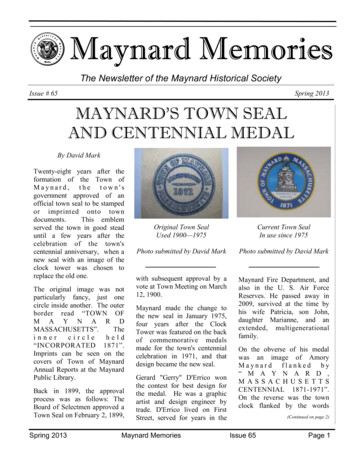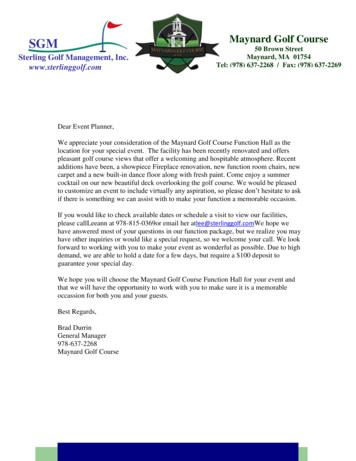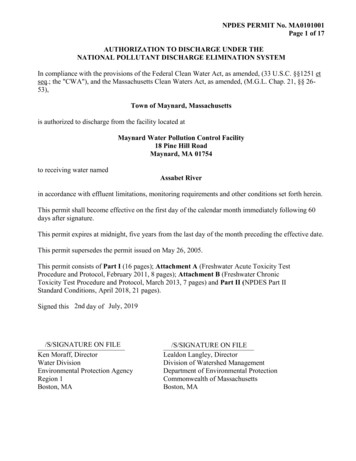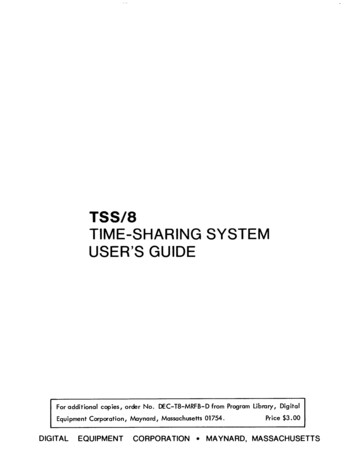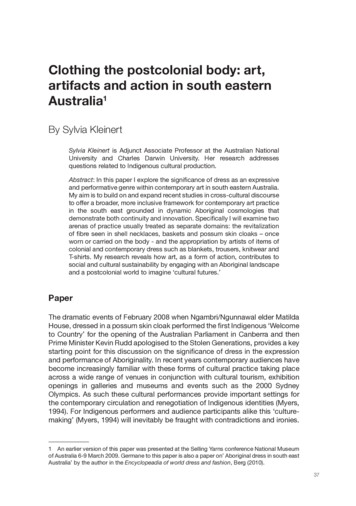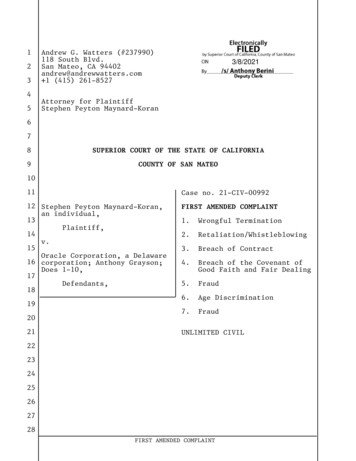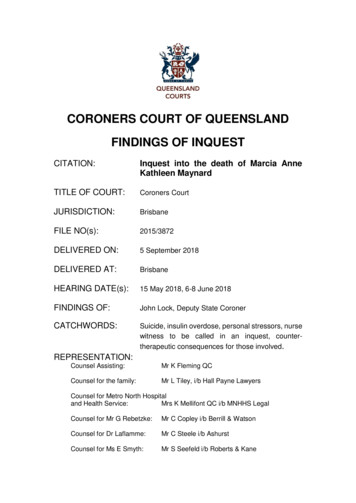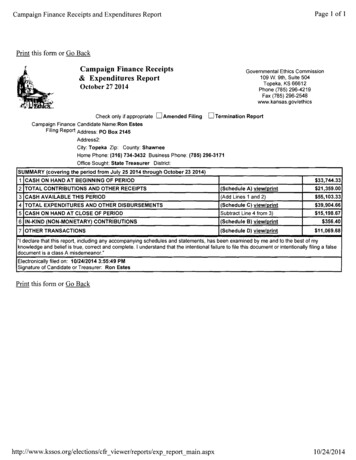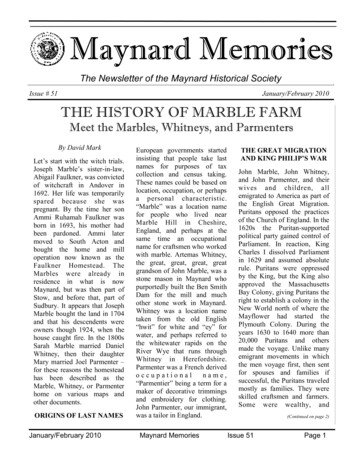
Transcription
The Newsletter of the Maynard Historical SocietyIssue # 51January/February 2010THE HISTORY OF MARBLE FARMMeet the Marbles, Whitneys, and ParmentersBy David MarkLet’s start with the witch trials.Joseph Marble’s sister-in-law,Abigail Faulkner, was convictedof witchcraft in Andover in1692. Her life was temporarilyspared because she waspregnant. By the time her sonAmmi Ruhamah Faulkner wasborn in 1693, his mother hadbeen pardoned. Ammi latermoved to South Acton andbought the home and milloperation now known as theFaulkner Homestead. TheMarbles were already inresidence in what is nowMaynard, but was then part ofStow, and before that, part ofSudbury. It appears that JosephMarble bought the land in 1704and that his descendents wereowners though 1924, when thehouse caught fire. In the 1800sSarah Marble married DanielWhitney, then their daughterMary married Joel Parmenter –for these reasons the homesteadhas been described as theMarble, Whitney, or Parmenterhome on various maps andother documents.ORIGINS OF LAST NAMESJanuary/February 2010European governments startedinsisting that people take lastnames for purposes of taxcollection and census taking.These names could be based onlocation, occupation, or perhapsa personal characteristic.“Marble” was a location namefor people who lived nearMarble Hill in Cheshire,England, and perhaps at thesame time an occupationalname for craftsmen who workedwith marble. Artemas Whitney,the great, great, great, greatgrandson of John Marble, was astone mason in Maynard whopurportedly built the Ben SmithDam for the mill and muchother stone work in Maynard.Whitney was a location nametaken from the old English“hwit” for white and “ey” forwater, and perhaps referred tothe whitewater rapids on theRiver Wye that runs throughWhitney in Herefordshire.Parmenter was a French derivedoccupationalname,“Parmentier” being a term for amaker of decorative trimmingsand embroidery for clothing.John Parmenter, our immigrant,was a tailor in England.Maynard MemoriesTHE GREAT MIGRATIONAND KING PHILIP’S WARJohn Marble, John Whitney,and John Parmenter, and theirwives and children, allemigrated to America as part ofthe English Great Migration.Puritans opposed the practicesof the Church of England. In the1620s the Puritan-supportedpolitical party gained control ofParliament. In reaction, KingCharles I dissolved Parliamentin 1629 and assumed absoluterule. Puritans were oppressedby the King, but the King alsoapproved the MassachusettsBay Colony, giving Puritans theright to establish a colony in theNew World north of where theMayflower had started thePlymouth Colony. During theyears 1630 to 1640 more than20,000 Puritans and othersmade the voyage. Unlike manyemigrant movements in whichthe men voyage first, then sentfor spouses and families ifsuccessful, the Puritans traveledmostly as families. They wereskilled craftsmen and farmers.Some were wealthy, and(Continued on page 2)Issue 51Page 1
Maynard Memories, The Newsletter of the Maynard Historical 635John1635RichardJohn1639John Jr.RichardGeorgeRichardDanielGeorge Deliverance Jr.NahumSarah--------------Daniel(last JoelMarble in house) Mary--------------------------Joel1900(died 1902)(died 1919)Bold if lived at site(Continued from page 1)brought servants. In 1641England’s Civil War startedbetween the Puritans and theKing, which led to theexecution of King Charles I andOliver Cromwell assuming rulein 1651. The Puritan outmigration fell to a trickle oncethe war started (and in factsome emigrants returned tofight in the war), but there wasenough of a critical mass for theNew England colonies tosucceed.King Philip’s War (167576), also known at Metacom’sWar, set the Wampanoag,Nipmuc, and Narragansett tribesagainst the colonists. Metacomwas the son of Massasoit, theWampanoag chief who hadbeen on good terms with theMayflower colonists and helpedthem survive their first winterPage 2of 1620-21. Metacom, who alsoused the English name “Philip,”saw the Indians progressivelydisplaced. He is quoted asstating “I am determined not tolive until I have no country."More than half of the 90 townsin New England came underattack. Lore has it that Indiansmet on Pompasittakutt Hill(now Summer Hill) to decidewhether to attack Concord orSudbury. The answer: Sudbury.Any early settlers in what isnow Stow and Maynard werelikely killed or driven off, theirhomes destroyed. TheMohegan, Poduck, and“Praying Indians” tribes aidedthe colonists. But the Indianswho sided with the colonistsalso suffered hardship. Somewere temporarily relocated toDeer Island in Boston Harbor,with inadequate food andMaynard MemoriesIssue 51EVENTSMayflower 1620Great Migration 1630-40England’s Civil War 1641-51King Philip’s War 1675-76Joseph Marble buysSudbury land 1704Revolutionary WarRailroadsCivil WarMaynard 1871World War IHouse burned in 1924shelter. Many died during thewinter. England’s governmentunder King Charles II did littleto aid the colonists during thisstruggle. Only after the war didcoloni al s ettl ers retu rn,establishing the town of Stow in1683 as encompassing landnorth and west of the AssabetRiver, all the way to Lancaster.MARBLE FAMILYThe model for colonialexpansion was for existingtowns to establish new clustersof homes and cleared farm andpasture land 5 to 10 miles awayas“plantations.”Pomposattakutt Plantation wasa 1669 spin-off settlement fromSudbury, as Acton was fromConcord. In 1683 the plannedS ud bu r y ex p ansi on wasincorporated as the town ofJanuary/February 2010
Maynard Memories, the Newsletter of the Maynard Historical SocietyStow. The border betweenSudbury and Stow was theAssabet River.The 1921 book “A BriefHistory of Maynard” states thatthe older portion of the houseowned by Joel F. Parmenter atthe time of his death in 1919had been “ built by oneMarble previous to 1683 witha barn dated 1722.” And a 1919obituary in The Maynard Newsadds that the Marble familycame over on the ship“Speedwell” about 1648, theland had been granted to them,and the house predated 1683.Evidence from varioushistoricalcollectionscontradicts this timeline. TheSpeedwell was supposed tohave been a sister ship to theMayflower but turned back in1620 and did not reach thecolonies before 1656. “AHistory of Stow” lists thecolonists who contracted tosettle in Stow around 1683 – noone named Marble. Andevidence puts the Marbles inAndover until at least 1700.John and Judith Marblearrived in 1635 on the ship“Jonathan.” Their son Joseph(born in 1650) moved toAndover. All of Joseph’sch i l d re n w er e b o rn inAndover – the last in 1691.Joseph was an Andover FenceViewer in 1692 and a GrandJuryman in 1695. He bought165 acres of land in Sudbury in1704, and is recorded asattending Sudbury TownMeetings in 1716 and 1717.Joseph and sons John andEdmund are all listed as payingCounty taxes in Sudbury inJanuary/February 20101722. Joseph’s son Edmundwas listed as being a Sudburyresident when he married in1711 and for the birth of hisfirst child in 1717. Joseph diedin 1728. Thus, it appears that afairly large Marble clan movedto Sudbury some time after1704, either all at once orprogressively as more land wascleared and the house (houses)enlarged and added. What doesall this have to do with the sitein Stow/Maynard? As it turnsout, in 1730 a number ofresidents of Sudburysuccessfully petitioned to havetheir land annexed to Stow. Thelist of petitioners includes JohnMarble, Edmund Brown, andRobert Conant. The Parmenterobituary noted that the househad been located in three townswithout being ever moved fromits foundation. This would havebeen true if the land had beenpart of Sudbury until annexed toStow in 1730, then transferredto Maynard with the formationof Maynard in 1871. Futureresearch should focus on fromwhom Joseph Marble boughtthe land in 1704, and if thatperson had already cleared andbuilt on the site.In Stow, we have JohnMarble (born in 1680 inAndover) who married AbigailMerriam, their son John Marble(born in 1717) who marriedRebekah Farnsworth, and theirson John Marble (born in 1751)who married Lois Davis. Johnand Lois had four children buttheir three sons died young.Sarah, their surviving daughter,married Daniel Whitney, also ofStow in 1812. They had 12Maynard Memorieschildren. Sarah died in 1863,the last of the Marbles to live inthe home. Daniel died in 1870.Daniel and Sarah are buried inMaynard’s GlenwoodCemetery, in the same plot asSarah’s parents, John and LoisMarble.The Faulkner Connection: In1702, three men signedagreements and contracts todevelop land known as the IronWork Farm. They built millsand homes flanking a dam onFort Brook. This was themaking of the area now knownas South Acton. AmmiRuhamah Faulkner rented themills in 1738 and thenpurchased them in 1742.Ammi’s name is interesting.“Ammi” and “Ruhamah” arederived from Hebrew, andrespectively mean “my people”and “have obtained mercy.”That’s an appropriate name forsomeone whose mother and twopre-teen sisters had beenaccused of being witches in theSalem and Andover witch trialsof 1692-93, and whose mother,Abigail Faulkner, of Andover,would have been executed if notpregnant with him at the time ofher conviction. Joseph Marble,who was married to Abigail’ssister, posted bond in 1692 tohave Abigail’s daughtersreleased from jail. The NewEngland witch trials were a lateand distant echo of theEuropean witch hunts of 14801700 which had seen tens ofthousands of people, mostlywomen, accused of witcheryand executed. Fifty years afterthe Andover trials, Ammi’s(Continued on page 4)Issue 51Page 3
Maynard Memories, the Newsletter of the Maynard Historical Society(Continued from page 3)Marble cousins lived a milesouth of his Acton home, andlikely had their corn ground athis grist mill and their logs cutto beams and boards at histimber mill. Six generations ofFaulkners lived in the houseover a 202 year period.WHITNEY FAMILYThe Whitney Museum in NewYork. Eli Whitney of the cottongin. The Whitney’s involved inthoroughbred horse racing. TheWhitney founder of the Metsbaseball team. The Stowcemetery near Maynard has aseparate Whitney Gate to get tothe section where manyWhitneys are buried. Why so,so, so many Whitneys? JohnWhitney and his wife Elinorcame over in 1635 on the ship“Elizabeth and Anne” with foursons, and had four more sons inNew England. And thosechildren had children, and theirchildren had children TheWhitney Research Groupestimates that there are morethan 15,000 descendents ofJohn and Elinor Whitney!John and Elinor Whitneywere wealthy landowners inWatertown. Their son Richard(1626-1697) is listed as livingin Watertown as of 1673, butlater as one of the first settlersin Stow, in 1680 (from E. B.Childs: “A History of Stow”). Acluster of Whitneys are buriedin the Stow Lower VillageCemetery (on Route 62).Richard’s son Richard (16601723) is there next to his wife,Elizabeth. His son Richard(1692-1775) is there next to hisPage 4wife, Hannah. And next toHannah is Richard’s secondwife, also Hannah. Richard andHannah-1 had eight childrenbefore she died at the age of 50.Two years later he marriedHannah-2, a widow who hadfive children from her firstmarriage. Richard and Hannah2 had no additional children.They both passed away in 1775,after 30 years together.Richard’s son Daniel (17201782) is buried nearby, as is hisson Daniel (1749-1805). Butthat Daniel’s son, also namedDaniel (1785-1870) is buried inMaynard along with his wifeSarah Marble. The websitewiki.whitneygen.org/wrg hasthe family tree descending fromJohn and Elinor.PARMENTER FAMILYJohn Parmenter, church deacon,came over with his wife Bridgetand their son John Parmenter Jr.in 1639 – the ship’s name isunknown. Fresh off the boatthey moved to the SudburyPlantation, a spin-off settlementfrom Watertown. John Jr. andhis wife Amy had six children.Through their daughter Mary,one of the descendents wasSamuel Morse, inventor of thetelegraph.The Parmenters were tavernowners in Sudbury. After aseries of mundane names (John,John, George, George) twinswere born in 1709 namedDeliverance and Thankful.Perhaps it was a difficult birth?Deliverance’s sons DeliveranceJr. and Jason fought in theRevolutionaryWar.Deliverance Jr. returned toMaynard MemoriesIssue 51S u d b u r y, m arri ed M ar yOsborne and the two of themhad Nahum and eight otherchildren. Our line of interestgoes from Nahum to Joel F.Parmenter.The Shay’s RebellionConnection: “Taxation withoutrepresentation!” Not ten yearsafter the end of theRevolutionary War that cryagain arose in Massachusetts. In1786-87 farmers andtownspeople of centralMassachusetts rebelled againststate taxes set to pay off the wardebt. Jason Parmenter wasactive in the rebellion. He killeda Federal agent while evadingcapture, but was soon takenprisoner and sentenced to die.Deliverance Jr. and otherParmenters were among themany who wrote petitioningletters to the governor beggingfor a pardon. On the day Jasonwas to be hanged – andaccording to a story, when therope was already in placearound his neck – a pardonsigned by the newly electedGovernor John Hancock arrivedat Northampton via horseback.Jason Parmenter was a freeman. He did not return toSudbury.Deliverance Jr.’s greatgrandson Joel F. Parmenter wasborn in 1831. He married MaryL. Whitney in 1855. He boughthis way out of the Civil Wardraft in 1863, which was acommon practice at the time.He and Mary moved into theMarble/Whitney home in 1871,after Mary’s father died. Marydied in 1902. Joel died in 1919.They are buried in Maynard’sJanuary/February 2010
MaynardMaynardMemories,Memories, thethe NewsletterNewsletter ofof thethe MaynardMaynard HistoricalHistorical SocietySocietyGlenwood Cemetery.Joel and Mary Parmenterhad five children. The foursurviving at the time of theirfather’s death (Daniel, Richard,J. Willis, and Harry) were intheir 40’s to 60’s at the time andit appears that no one movedback into the house. Most of theParmenter property and a halfinterest in the house were soldafter Joel’s death in 1919,possibly to settle inheritances tohis children and grandchildren.Harry, the youngest son, washalf-owner of the house at thetime of the fire. He lived inWorcester. The other half wasowned by Martin Peterson ofMaynard. At the time of the firehalf was rented and half wasempty. The house was notrebuilt. In time, the land cameto be owned by the town ofMaynard.Maynard’s WWI Memorialshows Joel’s grandsons Joel F.and Daniel L. Parmenter,privates in the U.S. Army,dying in 1918. ParmenterAvenue and Parmenter Street,off of Concord Street, wereprobably named after DanielParmenter, who had a farm andlivery business there. RichardParmenter was described asbeing an overseer at the milland living on Summer Street.THE HOUSEThere is a photo of the house,date unknown, in the Gutteridgebook “A Brief History ofMaynard,” published in 1921.The Maynard Public Libraryhas the book in its historycollection. From the photo itappears to have been in theJanuary/February 2010Georgian Colonial style. Thisstyle, popular from 1700 to1830, was very much for uppermiddle class home owners. Forsuch a nice house it is surprisingthat it is so close to the railroaduntil one realizes that therailroad was built 100 yearslater. The foundation paces offto 32 x 28 feet with the frontfacing south. The west side hasa flight of stone stairs that hadled to the basement. The eastside has an extension of thefoundation which had supportedbay windows on the first andsecond floors. The back rightcorner had an extension of thefoundation to the north and anextension of stones past thefoundation. It is possible thatthe ex t ens ion p as t thefoundation was the crudefoundation for the originalhouse. The two large chimneysseen in the photo suggest thatwhen built the house was heatedby wood burning fireplaces inevery room. The windowsappear to be double-hung sashwindows. This innovation wasintroduced around 1700.Window counterweights werefound in the debris in thefoundation.Visible in the Gutteridgephoto behind the Parmenterhouse is a large complex ofbarns. Joel F. Parmenter’sobituary states that the barn wasmarked with a 1722 date. Thenewspaper report on the fire of1924 that razed the house statedthat the barn housed 26 horsesat the time of the fire, and wasunharmed. It does not say whoowned or operated the barn atthe time of the fire, but Joel’sMaynard Memoriesson Daniel Parmenter owned afarm and livery off of ConcordStreet at the time of the 1920federal census. The MaynardAssessor’s Records of 1924show 92 horses in Maynard,down from a peak of 256 in1900. By 1933, the last year thetown Assessor counted horses,only 17 horses remained.THE PRESENT DAYWhat the town of Maynardowns is a site where afarmhouse and outbuildingswere likely built after 1710. Thesite borders Rockland Avenue,off Acton Street just north ofwhere Acton Street meets Route27. The house burned on April2, 1924, leaving a debris-filled,stone walled foundation. Thereare no visible traces of the largebarns, which were to the west.The debris includes tons ofbroken chimney brick fromwhen the two large chimneyscollapsed during or after thefire. The foundation is eitherdry-laid or mortared field stonewith a partial top layer of large,squared-off granite blocks. Theother parts of the top layertumbled into the foundation andare part of the debris, or wereremoved after the fire to be usedelsewhere.There are two wells and foursets of stone steps on theproperty. The most striking ofthe stone steps is on the westside of the foundation, leadingfrom ground level down to thebasement. Each of the eightsteps is one piece of granitespanning four feet from wall towall and weighing more than600 pounds (estimated fromIssue 51Page 5
Maynard Memories, the Newsletter of the Maynard Historical Societygranite density of 168 lbs/cu ft).There are also sizeable stonewalls framing the home site andproviding a border between thehomesite and the future AssabetRiver Rail Trail (the abandonedrailroad tracks).On April 4, 2009 MaynardBoy Scout Troop 130 spent thebetter part of a damp spring daycutting down trees and clearingbrush from the Marble Farmsite, and erecting a post andchain fence bordering two sidesof the foundation. This was anEagle Scout project by JasonSchomacker. A plaque on oneof the fence posts shows a photoof the house taken before thefire, with barns and otheroutbuildings seen in thebackground. The photo is fromGutteridge’s “A Brief History ofMaynard.” The site has thep o t en ti al fo r b eing aninteresting and easily visitableaddition to Maynard’s history,but without continuingmaintenance it gets rapidlyo v erg ro wn wi t h s u m ac,bittersweet, bramble, andpoison ivy.John (1605-1695) and Judith (unknown) Marble; 7 childrenJoseph (1650-1725) and Mary (Faulkner) Marble; 7 childrenJohn (1680-1762) and Abigail (Merriam) Marble; 4 childrenJohn (1717-1798) and Rebekah (Farnsworth) Marble; 6 childrenJohn (1751-1820) and Lois (Davis) Marble; 4 childrenSarah Marble (1791-1863) married Daniel Whitney in 1812 (seebelow)John (1592-1673) and Elinor (unknown) Whitney; 8 childrenRichard (1626-1697) and Martha (Coldam) Whitney; 8 childrenRichard (1660-1723) and Elizabeth (Sawtell) Whitney; 8 childrenRichard (1692-1775) and Hannah (Whitcomb) Whitney; 8 childrenRichard’s second wife was also named Hannah; they had nochildrenDaniel (1720-1782) and Dorothy (Goss) Whitney; 11 childrenDaniel (1749-1805) and Sarah (Durant) Whitney; 12 childrenDaniel (1785-1870) and Sarah (Marble) Whitney; 12 childrenMary Whitney (1837-1902) married Joel F. Parmenter in 1855 (seebelow)John (1558-1681) and Bridget (unknown) Parmenter; 1 childJohn Jr (1612-1666) and Amy (unknown) Parmenter; 6 childrenGeorge (1647-1727) and Hannah (Johnson) Parmenter; 1 childGeorge Jr (1679-1750) and Mary (Burke) Parmenter; 6 childrenDeliverance (1709-1785) and Ruth (Hayden) Parmenter; 11 childrenDeliverance Jr (1744-1804) and Mary (Osborne) Parmenter; 9childrenNahum (1780-1831) and Susanna (Willis) Parmenter; 13 childrenJoel (1802-1870) and Augusta (Hayden) Parmenter; 3 childrenJoel F. (1831-1919) and Mary (Whitney) Parmenter; 5 childrenBold if in a Maynard or Stow cemeteryBIRTHS, DEATHS, ANDWIVES’ MAIDEN NAMESThe Marble men in our lineagemarried women with maidennames Faulkner, Merriam,Farn s wo rt h , an d Dav i s.Whitney men married womennamed Coldam, Sawtell,Whitcomb, Goss, and Durant.Parmenter men married womennamed Johnson, Burke, Hayden,Osborne, and Willis.Right: Joel F. Parmenter Home(Photo from “A Brief History ofMaynard Mass.” by Gutteridge)Page 6Maynard MemoriesIssue 51January/February 2010
Maynard Memories, the Newsletter of the Maynard Historical SocietyAbove Left: Marble Homestead foundation as it is today. Above Right: Jason Schomacker and Boy ScoutTroop 130 completing the Eagle Scout project to clear and mark the site. (Photos by Peg Brown.)A Letter From theHistorical SocietyPresidentHappy New Year! As welook forward to 2010, I'd like tothank all of you who haves u p p o r t ed t h e M a yn a r dHistorical Society in past years.With the help of a number ofdedicated volunteers, we'remaking steady progress with themanagement of the Society'scollection. In September adocument conservationspecialist from the NortheastDocument Conservation Centerconducted a survey of ourcollection. In December wereceived the report of the surveyand we will be using it tostructure our short-term andlong-term planning. We werepleased with the report whichconcluded: "It was obviousduring the site visit that thecollections are being maintainedby an extremely careful andconscientious group ofvolunteers. With continuedsupport from MHS membersand from the Town, thematerials under their care—January/February 2010which document not only thehistory of Maynard, but alsoaspects of New England historyand national history—could bepreserved and made available toa wide range of researchers forgenerations to come."Anyone interested in seeingthe report (65 pgs), please feelfree to contact me. It isavailable online, at thePaymaster Building, and I’llbring a copy to the meeting.The Survey was funded bythe Town of Maynard throughthe Community PreservationAct. We are grateful to the townfor making CPA funds availablefor the survey, and for theirsupport of the inventory andpreservation project that willstart in 2010. The process ofcreating a new, computerizedcatalog is just getting started,and we'll be working on ways tohave people participate - evenfrom their homes.I'm deeply indebted toeveryone who helps keep theSociety a vibrant organization.Our board members andmembers who take time fromtheir busy lives to contributeMaynard Memoriestheir time and expertise to helpmanage the collection, doresearch for programs, watchover the budget, providerefreshments, and dozens ofother things that let ourmembership and the generalpublic learn about Maynard'shistory.I'm excited about what's tocome in 2010 and we'll keepyou up-to-date in futurenewsletters.Best wishes for a happy,healthy, and prosperous NewYear,Dave Griffindavebets@mac.com or978-897-4275---The NEDCC Survey reportsare located at: NEDCC-MHS-SurveyReport-full.pdf (full report) orh tt p :// web .m a yn ard .m a. us /histor y/societ y/projects/NEDCC-MHS-Survey-Reportexec.pdf (executive summary about a dozen pages)Issue 51Page 7
Maynard Historical Society195 Main StreetMaynard, MA 01754 Copyright 2010All rights reservedMaynard MemoriesThe Newsletter of theMaynard Historical SocietyTown Building195 Main StreetMaynard, MA 01754web.maynard.ma.us/historyPresidentDavid GriffinVice PresidentRoy HelanderSecretaryDiann StrausbergTreasurerDon WasiukPublic Relations OfficerSusan AlataloCuratorPaul BoothroydArchivistPeg BrownNewsletter EditorNancy WasiukNewsletter DistributionBobbie StatkusPurpose:To preserve the memories andmemorabilia of Maynard forcurrent and future generations.Page 8Upcoming ProgramsMondayJanuary 25, 2010MondayFebruary 22, 2010The Maynard Families,Homes, and FarmsDisplaced by WWIIThe MaynardDramatic ClubSpeaker: Paul BoothroydSpeakers: Roy Helander and DaveGriffinPaul will speak on those whooccupied the land prior to WWIIthat was taken by the governmentand became what was referred toas the Annex, now the AssabetRiver National Wildlife Refuge.Roy and Dave will speak on theMaynard Dramatic Club whichwas organized in 1936 withthirteen original members.Membership grew over the yearsto over 200 members.Refreshments: Diann StrausbergRefreshments: Rini SofkaTime: 7:00 p.m.Time: 7:00 p.m.Place: Lower Level Meeting RoomTown HallPlace: Lower Level Meeting RoomTown HallMaynard MemoriesIssue 51January/February 2010
Marble, Edmund Brown, and Robert Conant. The Parmenter obituary noted that the house had been located in three towns without being ever moved from its foundation. This would have been true if the land had been part of Sudbury until annexed to Stow in 1730, then transferred to Maynard with the formation of Maynard in 1871. Future


